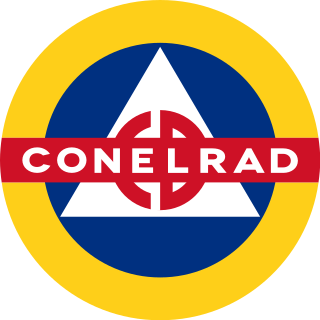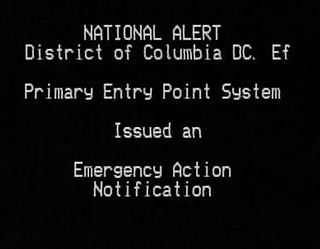Related Research Articles

The Emergency Broadcast System (EBS), sometimes called the Emergency Action Notification System (EANS), was an emergency warning system used in the United States. It was the most commonly used, along with the Emergency Override system. It replaced the previous CONELRAD system and was used from 1963 to 1997, at which point it was replaced by the Emergency Alert System.

Hilo is the largest settlement in and the county seat of Hawaiʻi County, Hawaiʻi, United States, which encompasses the Island of Hawaiʻi, and is a census-designated place (CDP). The population was 44,186 according to the 2020 census. It is the fourth-largest settlement in the state of Hawaiʻi, the largest settlement in the state outside of Oahu, and the largest settlement in the state outside of the Greater Honolulu Area.

CONELRAD was a method of emergency broadcasting to the public of the United States in the event of enemy attack during the Cold War. It was intended to allow continuous broadcast of civil defense information to the public using radio stations, while rapidly switching the transmitter stations to make the broadcasts unsuitable for Soviet bombers that might attempt to home in on the signals.

The Emergency Alert System (EAS) is a national warning system in the United States designed to allow authorized officials to broadcast emergency alerts and warning messages to the public via cable, satellite and broadcast television and AM, FM and satellite radio. Informally, Emergency Alert System is sometimes conflated with its mobile phone counterpart Wireless Emergency Alerts (WEA), a different but related system. However, both the EAS and WEA, among other systems, are coordinated under the Integrated Public Alert and Warning System (IPAWS). The EAS, and more broadly IPAWS, allows federal, state, and local authorities to efficiently broadcast emergency alert and warning messages across multiple channels. The EAS became operational on January 1, 1997, after being approved by the Federal Communications Commission (FCC) in November 1994, replacing the Emergency Broadcast System (EBS), and largely supplanted Local Access Alert systems, though Local Access Alert systems are still used from time to time. Its main improvement over the EBS, and perhaps its most distinctive feature, is its application of a digitally encoded audio signal known as Specific Area Message Encoding (SAME), which is responsible for the characteristic "screeching" or "chirping" sounds at the start and end of each message. The first signal is the "header" which encodes, among other information, the alert type and locations, or the specific area that should receive the message. The last short burst marks the end-of-message. These signals are read by specialized encoder-decoder equipment. This design allows for automated station-to-station relay of alerts to only the area the alert was intended for.
KHNL is a television station in Honolulu, Hawaii, United States, serving the Hawaiian Islands as an affiliate of NBC and Telemundo. It is owned by Gray Media alongside CBS affiliate KGMB, a combination known as Hawaii News Now. The two stations share studios on Waiakamilo Road in downtown Honolulu; KHNL's transmitter is located in Akupu, Hawaii. KHNL is also rebroadcast on the island of Hawaiʻi, Maui, and Kauaʻi.
KITV is a television station in Honolulu, Hawaii, United States, serving the Hawaiian Islands as an affiliate of ABC. It is owned by Allen Media Group alongside multicultural independent station KIKU. The two stations share studios on South King Street in downtown Honolulu; KITV's main transmitter is located atop the Ala Moana Hotel in Honolulu. Rebroadcasters on the islands of Maui and Hawaii extend the station's signal.

The Pacific Tsunami Warning Center (PTWC), located on Ford Island, Hawaii, is one of two tsunami warning centers in the United States, covering Hawaii, Guam, American Samoa and the Northern Mariana Islands in the Pacific, as well as Puerto Rico, the U.S. Virgin Islands and the British Virgin Islands in the Caribbean Sea. Other parts of the United States are covered by the National Tsunami Warning Center.

An emergency population warning, or public warning system is a method where by local, regional, or national authorities can contact or notify members of the public to warn them of an impending emergency. These warnings may be necessary for a number of reasons, including:

A warning system is any system of biological or technical nature deployed by an individual or group to inform of a future danger. Its purpose is to enable the deployer of the warning system to prepare for the danger and act accordingly to mitigate or avoid it.

WGU-20 was an emergency government civil defense preparedness radio station in Chase, Maryland, United States, operated by the United States Defense Civil Preparedness Agency in the 1970s.
KPRP is a non-commercial educational radio station licensed to Honolulu, Hawaii, United States, which serves the Honolulu metropolitan area. It is currently owned by SummitMedia, LLC, pending a donation to the Raleigh-Wake Chapter of the National Alumni Association of Shaw University.

Hilo Bay is a large bay located on the eastern coast of the island of Hawaiʻi.

A National Emergency Message, formerly known until 2022 as an Emergency Action Notification, is the national activation of the Emergency Alert System (EAS) used to alert the residents of the United States of a national or global emergency such as a nuclear war or any other mass casualty situation. This alert can only be activated by the president of the United States or a designated representative thereof, such as the vice president. The Emergency Broadcast System (EBS) also carried the Emergency Action Notification. Except for the 2011 national test, which utilized the Emergency Action Notification alert type, no president has ever issued a National Emergency Message.

Lena Machado was a Native Hawaiian singer, composer, and ukulele player, known as "Hawaii's Songbird". She was among the first group of musical artists honored by the Hawaiian Music Hall of Fame in 1995. Noted for her use of the Hawaiian vocal technique of "ha'i," which emphasizes the transition between a singer's lower and falsetto vocal ranges, and her use of "kaona" when writing song lyrics, she entertained primarily in Hawaii and the mainland United States. She sold leis on the Honolulu piers as a child, and aspired to become a singer like the women she saw greeting incoming passengers. KGU radio manager Marion A. Mulroney discovered her as she sang in a mango tree next door to his home. She performed regularly on KGU, where Royal Hawaiian Band conductor Mekia Kealakaʻi heard her and hired her as a featured soloist in 1925. Her association with the Royal Hawaiian Band would last five decades. During World War II, she had her own radio show on KGU.

On the morning of January 13, 2018, an alert was accidentally issued via the Emergency Alert System and Wireless Emergency Alert System over television, radio, and cellular networks in the U.S. state of Hawaii, instructing citizens to seek shelter due to an incoming ballistic missile. The message was sent at 8:08 a.m. local time and the state had not authorized civil defense outdoor warning sirens to sound.

Women's Air Raid Defense (WARD) was a World War II civilian organization that worked with the military to provide air defense for Hawaii. It formed in December 1941 after the attack on Pearl Harbor. Women volunteered in order to allow men to be freed from air defense work to go onto combat roles. WARD was the only civilian organization employed by the military for the purpose to replace men in active duty. It was disbanded after the end of WWII.

Myrtle Keahiʻaihonua Kalanikahea Hilo was a native Hawaiian taxicab driver, radio personality, ʻukulele player and singer. Her signature album The Singing Cab Driver was released in 1967 on Makaha Records. She was born in Hauʻula, Hawaii on the island of O'ahu. In 1998 she received the Lifetime Achievement Award from the Hawai'i Academy of Recording Arts.

Danny "Kaniela" Kaleikini was an American singer, musical artist, and entertainer. Best known for his long-term residency at the Kahala Hilton in Hawaii, where he performed for 28 years, Kaleikini is often called "The Ambassador of Aloha". During his career of more than 50 years in show business, he was the opening act for Paul Anka at Caesars Palace in Las Vegas, and performed alongside Sammy Davis Jr., Wayne Newton, Dolly Parton, Phyllis McGuire, and Don Ho. A baritone who sang Hawaiian songs and played the nose flute, Kaleikini gained international recognition for promoting Hawaiian music, language, and culture.

Amy Suehiro was a Japanese-American entomologist, based at the Bishop Museum in Hawai'i.
Events from 2018 in Hawaii.
References
- 1 2 Bernard, Charles (December 22, 1962). "Thousands Flee In Wave Warning". The Honolulu Advertiser. Honolulu, Hawaii. United Press International. p. 10. Retrieved January 29, 2024– via Newspapers.com.
- ↑ "Isle Alert System Called Outmoded". Honolulu Star-Bulletin. Honolulu, Hawaii. June 12, 1960. p. 18. Retrieved January 29, 2024– via Newspapers.com.
- ↑ "Wave Alert System Outdated, Dr. Eaton Tells Legislators: Other Testimony Also Backs Story Of May 23 Flaws". Hawaii Tribune-Herald. Hilo, Hawaii. Associated Press. June 11, 1960. p. 1. Retrieved January 29, 2024– via Newspapers.com.
- ↑ Edwards, Ed (May 21, 1961). "1960 Destruction Sparks Research Program At University That Offers Hope for Future". Honolulu Star-Bulletin. Honolulu, Hawaii. p. Sports 6. Retrieved January 29, 2024– via Newspapers.com.
- ↑ Sherman, Eddie (December 2, 1960). "Eddie Sherman". Honolulu Star-Bulletin. Honolulu, Hawaii. p. 38. Retrieved January 29, 2024– via Newspapers.com.
- ↑ "Alert System Is Ready To Go, Officials Say". Hawaii Tribune-Herald. Hilo, Hawaii. Associated Press. November 18, 1960. p. 1. Retrieved January 29, 2024– via Newspapers.com.
- ↑ "New Civ-Alert System Is Successful in Test". Honolulu Star-Bulletin. Honolulu, Hawaii. January 4, 1961. p. 12. Retrieved January 29, 2024– via Newspapers.com.
- ↑ Stone, Scotty (June 11, 1961). "State Defense Aides Back Alarm System". The Honolulu Advertiser. Honolulu, Hawaii. p. A-4. Retrieved January 29, 2024– via Newspapers.com.
- ↑ "State to Replace Conelrad Attack Warning System". Honolulu Star-Bulletin. Honolulu, Hawaii. July 28, 1961. p. 29. Retrieved January 29, 2024– via Newspapers.com.
- ↑ "Tightening Of Alert System Promised". Hawaii Tribune-Herald. Hilo, Hawaii. February 22, 1963. p. 4. Retrieved January 29, 2024– via Newspapers.com.
- ↑ Nelson, Lyle (April 4, 1963). "Simplified Civil Defense Warning System Sought". Honolulu Star-Bulletin. Honolulu, Hawaii. p. 31. Retrieved January 29, 2024– via Newspapers.com.
- ↑ "Intelligent Alert". The Honolulu Advertiser. Honolulu, Hawaii. February 5, 1965. p. B2. Retrieved January 29, 2024– via Newspapers.com.
- ↑ Bornstein, A. E.; Bosak, N. M.; Hoddy, L. J.; Miller, B. D.; Rosenthal, M. I.; Lamoureux, R. L. (November 30, 1966). "Warning Systems Research Support: Final Support" (PDF). System Development Corporation. p. 85.
- ↑ "State of California Emergency Alert System Plan" (PDF). California Governor's Office of Emergency Services. October 11, 2017. p. 27.
- ↑ Mitchell, Wallace (March 30, 1967). "Isles Linked to National Emergency Radio Line". The Honolulu Advertiser. Honolulu, Hawaii. p. B1. Retrieved January 29, 2024– via Newspapers.com.
- ↑ "Civ-Alert Gets a New Name". Honolulu Star-Bulletin. Honolulu, Hawaii. May 27, 1977. p. E-8. Retrieved January 29, 2024– via Newspapers.com.